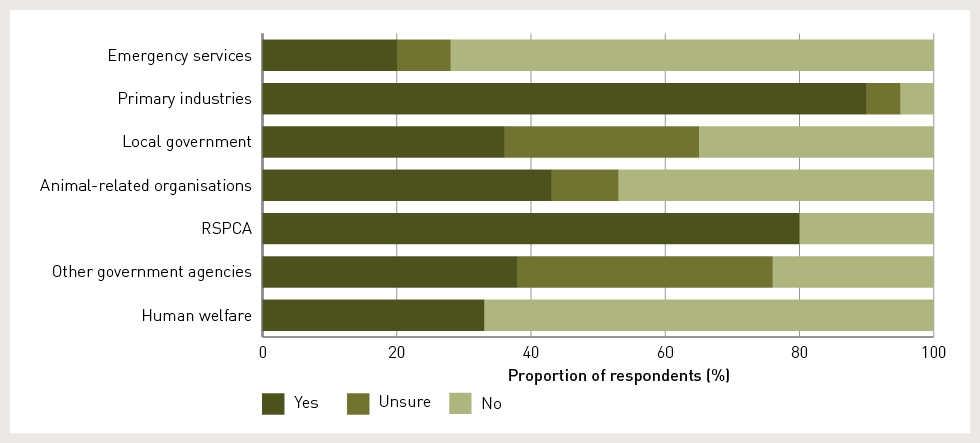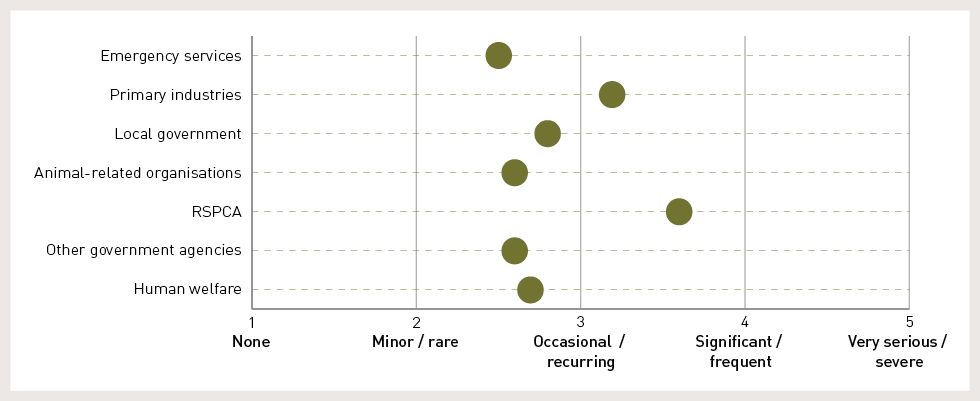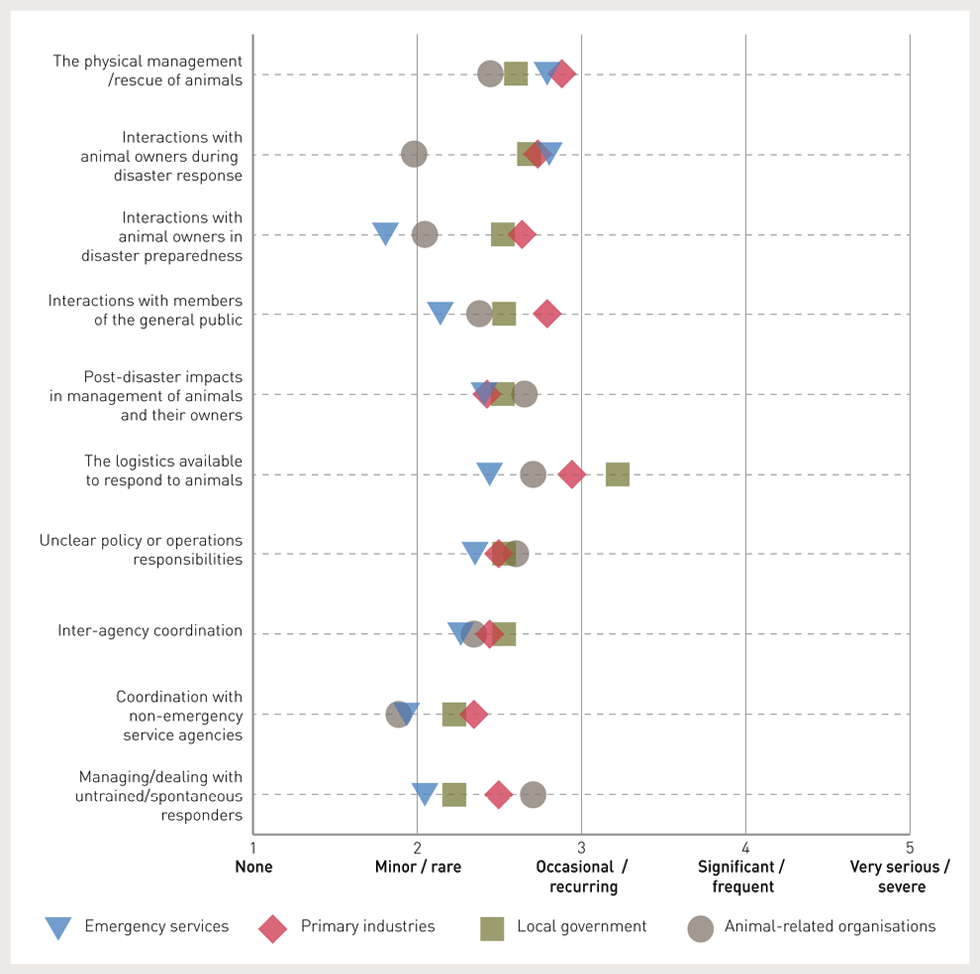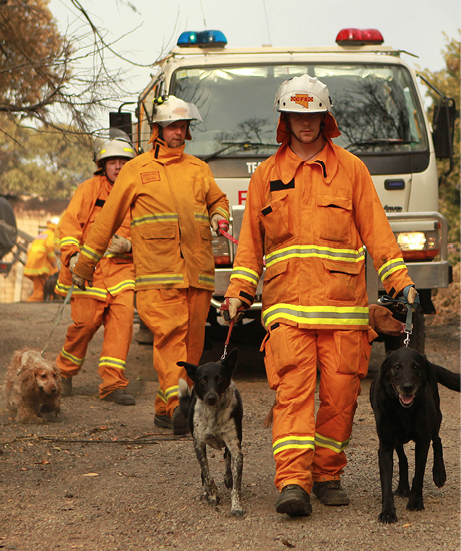The challenges of managing animals and their owners in disasters: perspectives of Australian response organisations and stakeholders
Dr Melanie Taylor, Megan McCarthy, Dr Penelope Burns (University
of Western Sydney), Dr Kirrilly Thompson, Dr Bradley Smith (CQUni
Appleton Institute) and Greg Eustace (RSPCA Queensland)
Peer-reviewed Article
Abstract
A sample of 98 respondents representing 68 organisations from all Australian states and territories were surveyed. The main challenges identified in the management of animals and their owners were in the logistics of animal management (personnel and equipment), the physical management and rescue of animals, interactions with owners during emergency response, and post-emergency impacts on the management of animals and their owners (distress and emotional issues). As would be expected, different categories of organisations and stakeholders experienced different challenges. Issues were reported across all categories irrespective of their formally-assigned roles and responsibilities in this area.
Article
Introduction
There is a plethora of plans, guidelines, and legislation regarding animal welfare emergency management for companion animals, livestock and wildlife. Although the body of supporting academic literature is increasing in size and scope, Australian research remains relatively scant. Studies tend to be focused on North American contexts, and are heavily framed around animal owners and their failure to evacuate, their risk-taking to save animals, and the emotional impacts of animal loss (Heath et al. 2001a, Heath, Voeks & Glickman 2001b, Zottarelli 2010, Lowe 2009, Hunt 2008). Hall et al. (2004) go beyond the owner perspective to acknowledge those who work with animals in emergency situations, such as veterinarians and government officials, may also suffer physical and psychological stress. The limited research that focuses on emergency management and response in the context of animals in emergencies and disasters is predominantly directed towards the logistics of planning for animals, information management needs, and justification of the need to include animals in emergency and disaster planning (Leonard & Scammon 2007, Edmonds & Cutter 2008, Austin 2013, White 2014).
Despite the lack of Australian empirical research in the area, there has been an increased awareness of the importance of plans and strategies that consider the needs of animals and their owners in emergency situations. In Australia, reports from the 2011 Queensland Flood Commission of Enquiry, the 2009 Victorian Bushfires Royal Commission, and the 2013 Tasmania Bushfires Enquiry have all included reference to the management of animals, and improvements required in response co-ordination, emergency management, and consideration of the human-animal bond. The National Strategy for Disaster Resilience (COAG 2011) has shaped the Australian approach taken in all aspects of emergency management and the strategy has promoted disaster resilient communities. Given the high rates of companion animal ownership in Australia (63 per cent) (Animal Health Alliance 2013) and the well-documented and profound impacts of pet and animal loss on owners (Zottarelli 2010, Hall et at. 2004, Thompson 2013), it would appear that a fundamental requirement of current emergency management should be the consideration of companion and commercial animals at all stages of emergency preparedness and planning.
With the recent endorsement of the National Planning Principles for Animals in Disasters by the Australia-New Zealand Emergency Management Committee there appears a willingness to work towards better integration of animal considerations into the emergency management planning and response of relevant organisations, stakeholders and animal owners. Many people are potentially affected by these plans; however, there is little extant research that specifically focusses on the diverse range of response organisations and stakeholders involved in the management of animals and their owners in emergencies. There are challenges to the co-ordination of relevant public and private organisations during emergencies, including cultural, organisational, jurisdictional and legal barriers (Janssen et al. 2010). Indeed, as Irvine (2007) argues, animal stakeholders of all kinds ‘have unique needs in disaster planning and response’ (Irvine 2007). Therefore, there is a need for research that understands the distinctive operational, social, political, and economic factors in Australia that influence the varied stakeholders who encounter the human-animal interface in emergencies. This study begins to address this gap by exploring the challenges and notions of responsibility of various stakeholders including departments of primary industry, emergency services organisations, and local councils in Australia.
Understanding the experiences and attitudes of those involved with the management of animals during emergencies helps the development of best practice approaches to animal welfare emergency management that provides engagement with animal owners and other stakeholders in emergencies. This includes improving outcomes for public safety and the resilience of responders, animal owners, those with animal-related businesses, and communities. This study, along with a mirror study with frontline responders (Taylor et al. 2014) and studies with animal owner groups, was undertaken to aid the understanding of the breadth and the relative extent of the issues encountered, and the perspectives of a range of different response organisations and stakeholders operating in Australia.
Method
Survey design: An online survey was developed to explore a range of potential issues and challenges related to the management of animals and their owners in emergencies. The survey design and content were guided by prior research (Taylor et al. 2014). The survey was administered online via Surveymonkey™ and data were collected over a six-week period, from mid-July to end-August 2014.
Sampling: A two-stage approach was used for sampling. A set of core response organisations was identified comprising all the state and territory fire agencies, State Emergency Services, police services, departments of primary industry, environment agencies, Australian Veterinary Association regions, RSPCA divisions, and relevant government agencies and Industry peak bodies (n=82). Invitations to take part in the study were sent to the Senior Director/Head of each organisation with a request to nominate someone from the organisation to complete the survey. In the second stage, a set of expert contacts from across animal health and welfare organisations, industry associations, local government, non-government organisations (NGOs), and other stakeholder groups was identified (n=86) and invited to participate.
Analysis: Data from the survey were analysed using IBM SPSS V.21™. Simple descriptive statistics are presented to provide an overview of the top-level data.
Results
Sample description
Data were collected from 98 respondents representing 68 organisations. The response rate from the core response sample was 66 per cent (54/82) and from the expert contact sample it was 51 per cent (44/86); the overall response rate for the survey was 56 per cent (94/168). Figure 1 summarises the jurisdictional distribution of the responses.
Figure 1: Jurisdictional distribution of respondents/responding organisations.
Respondents were asked to provide the name of their organisation. These organisations were categorised to aid analysis. Table 1 summarises these organisational categories.
Table 1: Organisational category of sample.| Category | Organisation types/examples | N | % |
|---|---|---|---|
|
Emergency services |
Fire agencies, State Emergency Services, Police |
25 |
25.5 |
|
Primary industries |
State/Federal departments of primary industry |
20 |
20.4 |
|
Local government |
Councils |
14 |
14.3 |
|
Animal-related organisations |
Industry associations, animal welfare organisations, Australian Veterinary Association, wildlife care |
21 |
21.4 |
|
RSPCA |
State organisations |
5 |
5.1 |
|
Other government agencies |
Government agencies – Environment/Parks |
8 |
8.2 |
|
Human welfare |
NGOs, Human/Community services |
3 |
3.1 |
|
Other |
Independent/not included elsewhere |
2 |
2.0 |
As data in Table 1 show, the four largest organisational categories in the sample were emergency services organisations, primary industries, local government, and animal-related organisations. Respondents were asked to identify the oversight of their role within the organisation and most identified emergency management (68 per cent), operational response (67 per cent), animal management/animal welfare (64 per cent), and community engagement/disaster preparedness (60 per cent).
Operational responsibility for animal management and awareness of arrangements
In opening the survey participants were asked whether they felt their organisation should have responsibilities for the management of animals in emergency situations. Overall, 46 per cent felt that their organisation should have responsibilities, 41 per cent felt they shouldn’t, and 13 per cent were unsure. Figure 2 summarises the responses by organisational category.
Figure 2: Do you think your organisation should have responsibilities for management of animals in disaster/emergency situations?
Although respondents from some organisational groupings clearly felt they should have responsibilities for the management of animals, such as primary industries and RSPCA, others, such as emergency services organisations did not (72 per cent ‘no’). Interestingly, local government and other government agencies were least sure with a more even split in views across the three response options.
Respondents were asked whether they were aware of any formal animal emergency response and recovery arrangements in their state. Overall, two thirds (66 per cent) reported they were, 19 per cent reported that they weren’t, and 14 per cent were unsure. Figure 3 summarises these data by organisational category.
Figure 3: Are you aware of any formal animal emergency response and recovery arrangements within your State?
Figure 3 shows the majority of respondents reported they were familiar with response and recovery arrangements, especially those in primary industries, however other groups were less certain or less aware. Many respondents provided comments in relation to this section of the survey. Mostly they outlined their organisation’s role or position in the broader emergency context, or they identified the RSPCA as playing a major role, or they were focussed at the local level and were less certain of how their organisation’s role was co-ordinated with that of others.
Problems or difficulties around the management of animals and their owners.
This section of the survey included questions about the general level of problems or difficulties encountered by respondents’ organisations around the management of animals and their owners. A second question asked the extent to which a set of ten further, more specific, potential challenges were encountered. Table 2 summarises the overall extent of problems in this area across the whole sample and Figure 4 shows a numeric value assigned to each response option to simplify the data and provide a mean rating for each organisational category.
Table 2: Extent of difficulties faced around the management of animals and their owners.| In general, are there problems or difficulties for your organisation around the management of animals/animal owners in disasters/emergencies? | N | % |
|---|---|---|
|
No, none at all |
7 |
7.6 |
|
Some minor or rare issues |
29 |
31.5 |
|
Occasional or recurring issues |
39 |
42.4 |
|
Significant or frequent issues |
13 |
14.1 |
|
Very serious or severe issues |
4 |
4.3 |
Figure 4: Mean ratings of general extent of problems or difficulties experienced in the management of animals and their owners. (1='No, none at all'; 5 = 'very serious or severe issues').
Data in Figure 4 indicate that greater/more serious issues were reported by RSPCA representatives, followed by those from Primary Industries. Respondents from emergency services organisations reported the least issues.
Figure 5 presents mean rating data for ten specific challenges that might be encountered by response organisations and other stakeholders. These data are broken down to summarise the responses of the four largest organisational groups in the survey.
Figure 5: Mean ratings of problems or difficulties experienced in the management of animals and their owners, broken down by the four largest organisational groups in the sample.
(1=’No, none at all’; 5 = ‘very serious or severe issues’)
Figure 5 shows there was variability in the mean ratings across areas and between the organisational categories for each area. In many areas these differences were quite small and unlikely to be statistically significant. Logistics issues were a greater challenge for many organisations overall, and specifically for the primary industries and local government organisations. Emergency services organisations indicated that physical management of animals and interactions with animals and owners during response were greater issues. Physical management of animals and interactions with the general public were slightly greater challenges for Primary Industry organisations and local government, and managing untrained/spontaneous animal-related responders and post-emergency impacts appeared to be greater challenges for animal-related organisations.
Discussion
The data represents the views of a large number of response organisations and other stakeholders that have a level of involvement in the management of animals and their owners in emergencies.
In terms of organisational responsibility it is clear that primary industries organisations generally feel that this should be their responsibility and they report being aware of the relevant response and recovery arrangements. They are also a group likely to encounter greater challenges in this area, especially around the logistics of response (personnel and equipment) and interactions with members of the general public with regard to animals in emergencies. In most states and territories the Primary Industries agency is the lead agency for animal welfare emergency management.
Emergency services organisations, however, generally feel they should not have this responsibility and report being less aware/more unsure of the relevant response and recovery arrangements. This finding is fairly unsurprising, given that the primary role of many of the agencies in this group is to manage the hazard/s and to protect human life. However, it is also clear that frontline responders from these organisations are most likely to be the ones on the scene during a response when issues with animals and owner management arise. The nature of the specific challenges reported by emergency services organisations reflects this, with issues around the interaction with owners during response and the physical management and rescue of animals being the ones reported as more frequent or serious.

Paracombe and Tea Tree Gully CFS volunteers lead dogs to safety during a fire in the Adelaide Hills, South Australia 2014. Image: Dylan Croker, Fairfax Media. Permission granted.
The responses of local government stakeholders indicate that overall views on the level of responsibility in this area are mixed, and awareness of relevant arrangements is lower than for other groups. Furthermore, local government respondents reported a broader range of challenges in this area including inter-agency co-ordination, unclear policy/responsibilities, and post-emergency impacts, in addition to those already mentioned (e.g. logistics). The reasons for these results are unclear. Variability in the sample in terms of respondents’ jurisdictions/locations and therefore their formal responsibilities in this area, or less familiarity with emergency arrangements per se, may help to explain this. It is highly likely, though, that local government organisations are more diverse as a group than the emergency services organisations and primary industry groups in the sample, and are focussed at a local level with regard to emergency management. It is also true that in this study they were not sampled systematically in the way the other two groups were.
Animal-related organisations are another diverse group in the sample and their responses reflected a degree of variability, probably because some represent industry associations, some veterinary care, and others animal welfare. The challenges are varied also; more aligned to those of local government than to the other two larger organisational groups. In addition to the challenges already mentioned, animal-related organisations reported greater issues with untrained/spontaneous responders.
Due to lower representation of some groups in the study sample, less has been reported about those groups. The RSPCA responses stand out, in terms of their views on organisational responsibility and the extent of challenges faced in the context of emergencies. As a charity organisation the response and recovery role of the RSPCA is complex and the extent of its role in any given situation may depend on local or state government arrangements even though many other organisations, as well as the general public, identify the RSPCA as a focus for animal rescue and management at these times. The challenges for expectation management are evident, with the RSPCA often experiencing a mismatch in their role and other agency/individual perceptions regarding animal welfare emergency management.
In reflecting on the study, the views of a wide range of response organisations and other stakeholders were elicited providing useful and informative insights in this area, in an Australian context. Although the sample was extensive it should be kept in mind that each organisation has specific roles and responsibilities within its jurisdiction and, in addition, response, management and perceived roles may vary depending on the nature of the emergency and the type of animal being managed. As the survey sought to obtain a ‘generalised’ overview of this area it is likely that important local or specific issues may not be identified. Similarly, the survey was answered by only one person (occasionally two) in each organisation, albeit with the request to represent the views of the organisation more broadly. This approach has clear limitations and certain groups, such as local government, were represented in a limited/non-random way. Some caution should be taken in generalising these findings.
Conclusion
This is the first empirical identification of the challenges faced by a range of Australian response organisations and stakeholders when managing animals in emergencies. All organisations had a stake in managing animals in emergencies and all had experienced problems or difficulties. To minimise risk and confusion, avoid duplication, strengthen inter-agency collaboration and support frontline responders and animal owners, the findings suggest there is a need for the sector to improve the clarification and communication of roles and responsibilities for managing animals during emergencies.
These study findings are being used to prioritise research as part of a project in the Bushfire and Natural Hazards CRC, and they will be used to guide discussions about the range of issues faced before, during, and after emergencies to help inform policy and training.
| Acknowledgements
The authors would like to thank the organisations and individuals taking part in the study. The support of the Commonwealth of Australia through the Cooperative Research Centre program is acknowledged. |
References
Animal Health Alliance 2013, Pet ownership in Australia. At: http://223.27.22.40/~sh10135/wp-content/uploads/2013/08/Pet-Ownership-in-Australia-2013-Summary-report-2013.pdf [Accessed 28/11/2014].
Austin JJ 2013, Shelter from the storm: Companion animal emergency planning in nine states. Journal of Sociology and Social Welfare, 40, 4, pp. 185-210.
COAG 2011, National Strategy for Disaster Resilience: Building Our Nation’s Resilience to Disasters, Council of Australian Governments, Canberra, Australia.
Edmonds AS & Cutter SL 2008, Planning for pet evacuations during disasters. Journal of Homeland Security and Emergency Management, 5, p. 1.
Hall MJ, Ng A, Ursano RJ, Holloway H, Fullerton C, & Casper J 2004, Psychological Impact of the Animal-Human Bond in Disaster Preparedness and Response. Journal of Psychiatric Practice, 10 (6), pp. 368–374.
Heath SE, Kass PH, Beck AM & Glickman LT 2001, Human and Pet-related Risk Factors for Household Evacuation Failure During a Natural Disaster. American Journal of Epidemiology, 153, pp. 659–665.
Heath SE, Voeks SK & Glickman LT 2001, Epidemiologic features of pet evacuation failure in a rapid-onset disaster. Journal of the American Veterinary Medical Association, 218, pp. 1898–1904.
Hunt M, Al-Awadi H & Johnson M 2008, Psychological Sequelae of Pet Loss Following Hurricane Katrina. Anthrozoos: A Multidisciplinary Journal of The Interactions of People & Animals, 21(2), pp. 109–121. doi: 10.2752/175303708X305765.
Irvine L 2007, Ready or Not: Evacuating an Animal Shelter During a Mock Emergency. Anthrozoos: A Multidisciplinary Journal of The Interactions of People & Animals, 20(4), pp. 355–364. doi: 10.2752/089279307x245482.
Janssen M, JinKyu L, Bharosa N & Cresswell A 2010, Advances in multi-agency disaster management: Key elements in disaster research. Information Systems Frontiers, 12(1), pp. 1–7. doi: 10.1007/s10796-009-9176-x.
Leonard HA & Scammon DL 2007, No Pet Left Behind: Accommodating Pets in Emergency Planning. Journal of Public Policy and Marketing. 26, pp. 49–53.
Lowe S, Rhodes J, Zwiebach L & Chan C 2009, The Impact of Pet Loss on the Perceived Social Support and Psychological Distress of Hurricane Survivors. Journal of Traumatic Stress, 22(3), pp. 244–247.
Taylor M, Eustace G, Smith B, Thompson K, Westcott R & Burns P 2014, Managing Animals in Disasters (MAiD): The experiences of emergency services personnel in supporting animals and their owners in disasters. Proceedings of the Bushfire and Natural Hazards Cooperative Research Centre Research Forum, Wellington, NZ. At: www.bnhcrc.com.au/publications/biblio/bnh-1562.
Thompson K 2013, Save me, save my dog: Increasing natural disaster preparedness and survival by addressing human-animal relationships. Australian Journal of Communication, 40, pp. 123–136.
White JI 2014, Supporting the Information Management Needs of People Helping Animals in Disasters. Paper presented at the Proceedings of the 18th International Conference on Supporting Group Work, Sanibel Island, Florida, USA.
Zottarelli LK 2010, Broken Bond: An Exploration of Human Factors Associated with Companion Animal Loss During Hurricane Katrina. Sociology Forum, 25, pp. 110–122.
About the authors
Dr Melanie Taylor is an occupational psychologist working in risk perception and risk-related behaviour.
Megan McCarthy is an anthropologist with experience working in the area of animals in disasters in Thailand.
Dr Penelope Burns is a General Practitioner and a researcher working in disaster medicine with a particular interest in physical and mental health in the recovery.
Dr Kirrilly Thompson is a cultural anthropologist with interests in human-animal relations and risk.
Bradley Smith is a psychologist and a researcher with expertise in the cognition and behaviour of canids, and the relationship between humans and animals.
Greg Eustace is a practitioner in emergency management and the psychosocial impacts of disasters with experience in animal management in emergencies.
Authors are involved in the Bushfire and Natural Hazards Cooperative Research Centre project ‘Managing Animals in Disasters: improving preparedness, response, and resilience through individual and organisational collaboration’.


